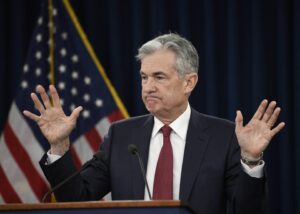Fed Poised to End Quantitative Tightening: What It Means for Banks, Markets, and Traders
Why end QT now?
- Funding stress markers: SRF take-up recently touched pandemic-era levels, a hint that reserves are nearing the Fed’s “ample” threshold (liquidity sufficient, but not flush).
- Policy mix shift: Chair Jay Powell signaled rate cuts “in the coming months”; markets are pricing another 25 bp cut to 3.75%–4.00% today. Ending QT reduces the risk of an accidental liquidity squeeze working at cross-purposes with rate easing.
- 2019 lesson: Officials are wary of a repeat of the Sept-2019 repo spike, when reserves fell faster than expected and short-term rates leapt above target.
- QE: Fed buys Treasuries/MBS, expanding reserves and easing financial conditions.
- QT: Fed allows maturities to roll off without reinvestment, shrinking reserves and tightening conditions.
- Since April, runoff was already slowed (Treasuries cap cut to ~$5B/month; MBS up to ~$35B/month continues). The Fed ending quantitative tightening would halt (or near-halt) the runoff to stabilize reserves.
What changes for banks and money markets
Bank reserves
Ending QT helps stop the bleed in reserves, lowering odds of a scramble for cash at quarter-ends and large settlement days. That eases pressure on funding desks and curbs volatility in overnight rates.
SOFR & repo
With QT paused, overnight benchmarks (SOFR/GC repo) should track the policy rate more smoothly, reducing the need for SRF backstops and dampening intraday rate spikes.
Treasury plumbing
Less runoff means more balance-sheet capacity to absorb issuance. It won’t fix supply dynamics, but it trims one headwind for auction tails and term-premium creep.
Market implications
- Rates: Curve bull-steepening risk if the short end rallies on cuts while term premium remains sticky. Front-end funding spreads should compress.
- Credit: Tighter funding spreads and steadier repo tone are credit supportive, especially for short-dated IG and financials.
- Equities: A liquidity tailwind favors banks with wholesale funding sensitivity and rate-sensitive sectors (REITs, housing-adjacent), but Fed guidance on reinvestments will shape durability.
- Mortgages: If the Fed keeps up to $35B/month in MBS roll-offs while ending Treasury runoff, MBS basis could remain choppy relative to swaps/Treasuries.
The decision tree: likely paths
Base Case: End Treasury QT now
- Pause Treasury runoff; maintain (or slow later) MBS roll-offs.
- Message: “Reserves are ample; we’ll reinvest to keep it that way.”
- Impact: Calmer funding; modest rally front-end; supportive for financials.
Gradualist: Signal December end
- Strong hint today; formal stop at next meeting.
- Impact: Eases volatility premium but prolongs reserve drift.
Surprise: Full reinvestment (QE-lite)
- Immediate reinvestment of all maturities.
- Impact: Bullish risk; raises “too easy” debate given inflation optics.
Key watch-items for desks
- Fed statement & press conference: Exact language on “abundant” vs “ample” reserves and reinvestment mechanics.
- SRF usage & SOFR prints: A quick fade in SRF take-up post-decision would confirm relief.
- Treasury General Account (TGA) path and bill issuance: TGA rebuilds can still siphon reserves; bill mix matters for money funds and RRP balances.
- MBS policy: Whether MBS roll-offs continue unchanged or get tapered later.
Risks & pushback
- Inflation optics: Critics argue QE/QT cycles helped fuel the latest inflation surge; ending QT may be cast as “easing into sticky prices.”
- Residual tightness: If bill supply and TGA rebuilding outpace reinvestments, reserves may remain tight even after the Fed ending quantitative tightening.
- Communication error: An ambiguous roadmap could keep term funding premia elevated.
Bottom line
The case for the Fed ending quantitative tightening is straightforward: reserve scarcity signals are blinking, rate cuts are underway, and the 2019 episode looms large. Ending QT won’t solve every liquidity wrinkle, but it reduces the tail risk of a funding shock—a prerequisite for a smooth transition to lower policy rates.

